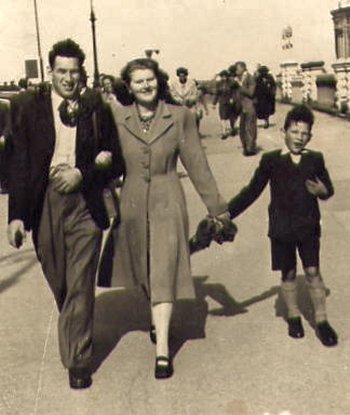

Peter Gordon Smith-Evans
Perhaps it would be good manners for me to introduce myself and provide your readers with some background about myself and some indication as to my association with Ludham.
I was born in Colwyn Bay in 1938 and as a result of an unsettled family background together with the outbreak of the second world war one year later, September 1939 that I found myself moving around the North Wales peninsular, living in digs of one type or another, with my father who was in the army during that time.
It was in 1946 that my father was posted to Ludham and met and Nancy Thrower, who in early 1947 he married. It was around this time, at about nine years of age, that I arrived in Ludham and took up residence down what I now understand is Malthouse Lane but in 1947 was known as Grimes Lane.
My father and Nancy
Thrower in 1946 just before I came to Ludham.
As you can imagine there was a vast difference between the hills of North Wales and the flat yet with its own individual character Norfolk and the extensive Broads waterways which became part of my boyhood life.
Perhaps this is sufficient to explain why I now put pen to paper to provide an insight in to life in Ludham during this time.
I arrived literally at the end of hostilities so the RAF Airfield and the Catfield road was still active with many aircraft such as Spitfires and Lancaster bombers using the base. The facility was quite extensive and extended from the end of the village by what was known as Malthouse Farm to Fritton and all the way up the Catfield road, the air traffic control was situated not far from the farm with the main runway running parallel to back road to Fritton.
The air base closed almost overnight as one day we were unable to access the area then the next day the entire area was void of all aircraft equipment and personnel whence, as boys do, we found a fantastic new adventure park with many interesting things still left behind. One such item was a complete spitfire’s propeller and the air traffic control tower was left almost as it was when it was operational.
It was not until I started to write this article that I fully appreciated just how insular each village was, almost like a family of its own. The same situation also existed with the boys that used to play together. It will be noted that I excluded girls in that remark not to be in any way sexist but in those days we just did not include the opposite sex in our activities.
Our geographical area was limited to Ludham Bridge, St, Benet’s Abbey, Potter Heigham, Catfield/Barton Broad, How Hill, Womack, and through along the marshes to what was then Kittle's Farm at Fritton. Of course the local rubbish tip was also a source of spare parts for our bikes, which were built from the tip, the tip was then situated just around the corner from Pop Snelling's house down towards Cold Harbour. Where we spent many hours investigating what people had thrown away. Yes there were no such things as environmental rubbish controls everything was picked in little refuse vehicles and put in a convenient hole in the ground.
Saturdays were taken up by a set of morning chores such as cleaning all the brass artefacts, which were considerable and also included door handles, changing the accumulator from the garage [for those who have not heard of accumulators they were a wet cell battery, usually made of glass, similar to a current day car battery used to provide a 12volts supply to run the radio on], cutting the lawn etc that were all done with the utmost of speed so that we could meet for the planned day's escapades.
There quite a few differences in the village geography such as the army camp down school road an the right hand side immediately after the school and the Blacksmith’s shop on the left opposite the school. At the bottom of School Road there was an operational sewerage works, which was again one of our places for entertainment, riding around on the water spray units. Just by the entrance there was a natural spring where we often drank water [not sewerage water hopefully]. The sewerage backed onto the Vicarage and provided a means to cut through to the Norwich road at the bottom of the hill, opposite where the Foundry was and the other side of the road to other Butcher's Shop.
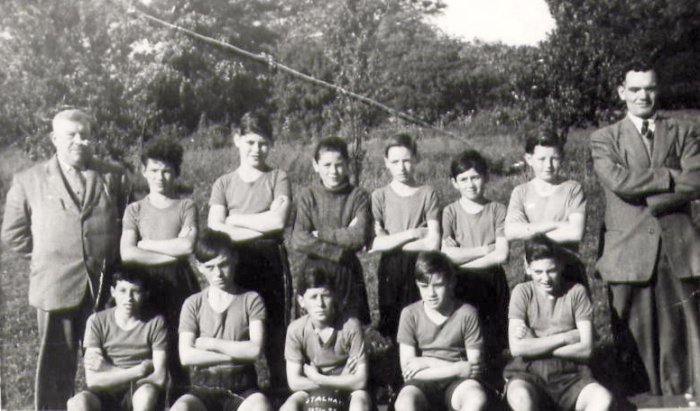
Stalham school about
1952 just prior to leaving school, which in those days
occurred at the age of fourteen.
School holidays were almost completely taken up with harvesting, not that we did any work. The corn was cut and we would round any good dogs in the village, often unbeknown to their owners, and go rabbiting as they ran from the ever-decreasing cornfield. The Binder machine, often pulled by horses would pick up the cut corn and tie it into bales which were stood up ready for collection and later collected an made into a large haystack [yet another place to play]. The next was the thrashing machine, steam driven and all the corn was removed. When the stack reached the base we would, again with aid of the village dogs, catch all the rats and mice .I expect that by now you are getting the impression that we were nasty boys and now looking back I can relate to that opinion, however, I would like think we were more akin to Tom Sawyer and Huckleberry Fin with a little bit of Lorna Doone and John Ridd thrown in.
As I am sure you will appreciate there was considerably more to our escapades than I have managed to include in this article but if asked what I consider is the main difference and having the benefit of hindsight and with two grandsons in their late teens, it would be the freedom to develop our characters without all the modern day clutter. It was, I believe, that period in Ludham and what I did as an individual that enabled me to stand on my own two feet from an early age without parental support.
In closing just a quick story that you may find amazing.
In 1956, on one of my visits to Australia and in particular Sydney, I went to the cinema just off St James Park and as usual everyone went for a break at the intermission (almost everybody leaves to have some form of break). I chose not to. The lights came on and I observed what appeared to be a familiar head but only a rear view, two rows in front of me. I waited until the person turned sideways to be sure and would you believe it, it was a school friend called Paddy Rudrum [if I have the spelling correct ] who lived on the council estate just prior to where School Road joins the Norwich Road. Some coincidence! He had gone out to Australia on a young farmers scheme in the early fifties. Unfortunately I never saw him again.

My wife Mary and I at
an official function in the mess in 1968 while serving
with the 10th Royal Hussars
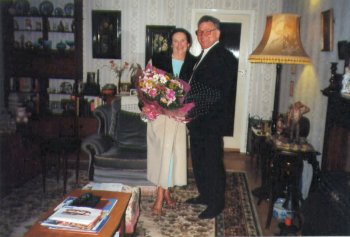
Our wedding anniversary
2001
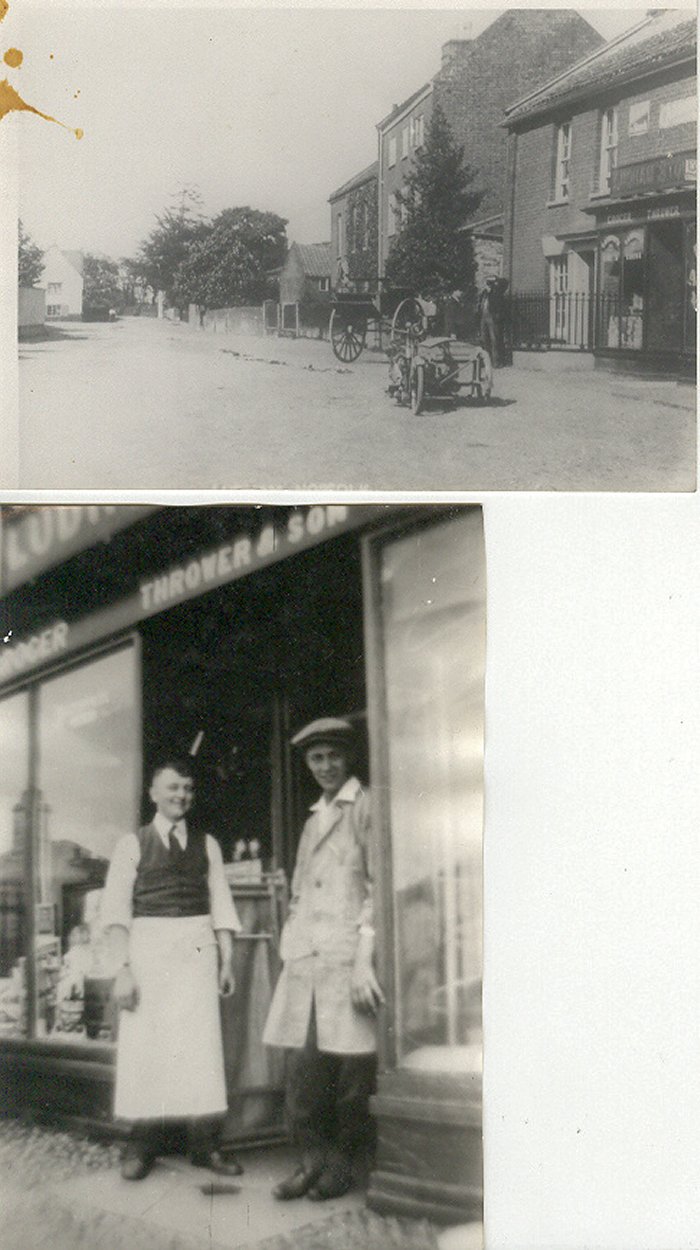
At Thrower's Shop
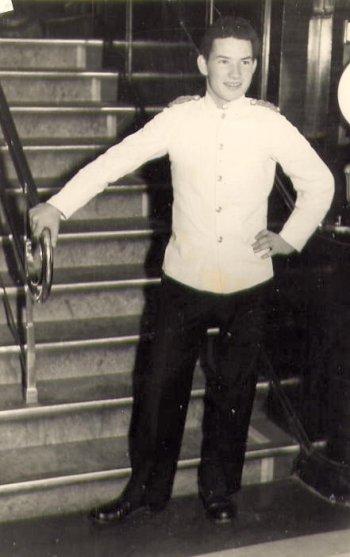
My first ship SS
Strathmore bound for Australia in 1955.
